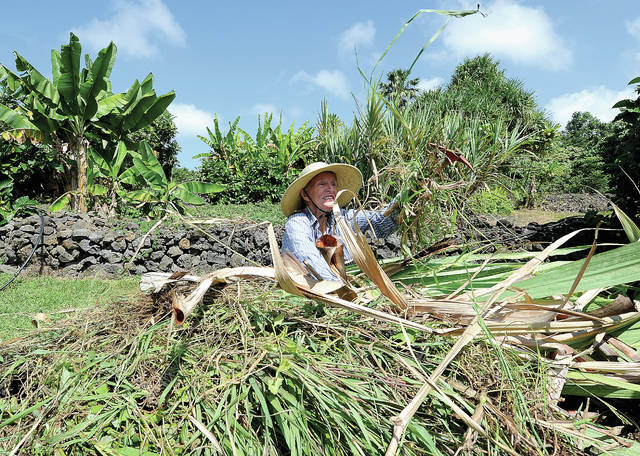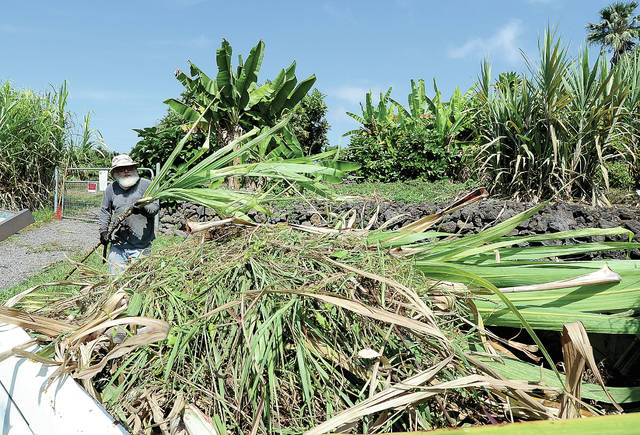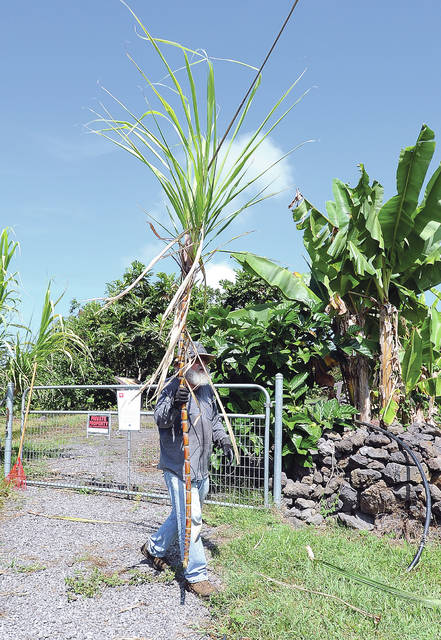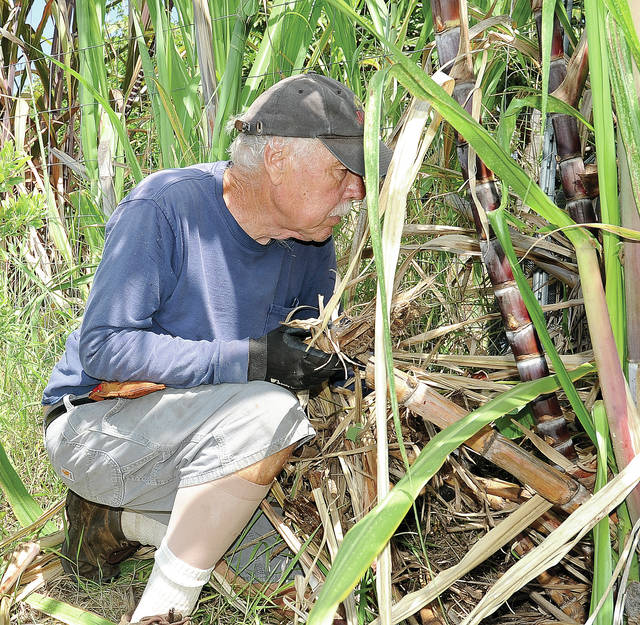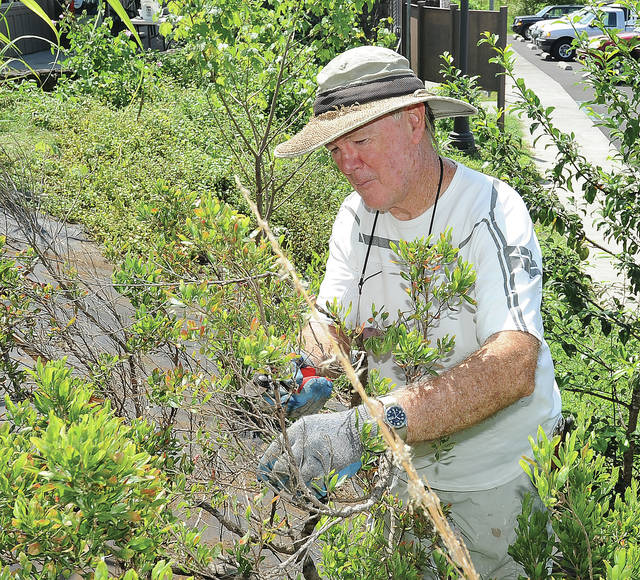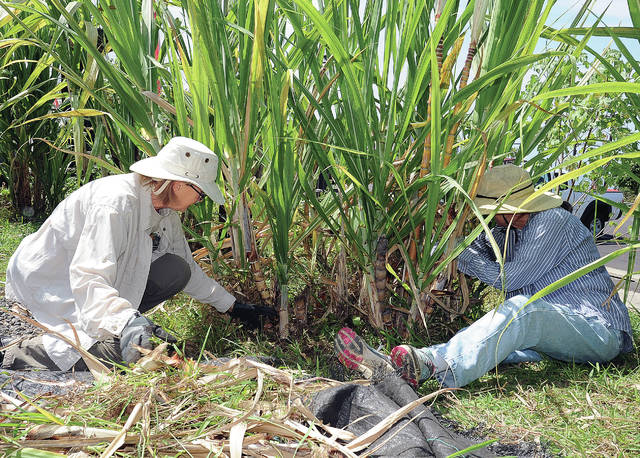CAPTAIN COOK — Situated just north of Manago Hotel, the Amy B.H. Greenwell Ethnobotanical Garden for years served as a living museum of Hawaii’s indigenous plants, inspiring visitors, residents and academics alike.
The legacy of botanist Amy Beatrice Holdsworth Greenwell, who lived at the property and transformed it to feature pre-contact flora, Greenwell left the property to Bishop Museum as an educational and cultural resource when she died at the age of 53 in 1974.
The Bishop Museum closed the 15-acre garden to the public in January 2016 after putting the land up for sale, but continues to employ a single staff member to manage the site, garden manager Peter Van Dyke.
“Fortunately,” said Maile Melrose, president of the nonprofit Friends of Amy B.H. Greenwell Ethnobotanical Garden, “because that’s why the garden hasn’t fallen apart.”
But even though the garden remains closed to the public as it awaits a buyer, a dedicated team of volunteers come together every Saturday to work in the garden.
“We sprang up to fill a need,” said Melrose. “You know someone’s got to help. Someone’s got to help maintain the garden, find a new owner for the garden and look out for the future of the garden.”
“So that’s us,” she said, “we’re the Friends of the Garden.”
The nonprofit Friends of Amy B.H. Greenwell Ethnobotanical Garden officially became a nonprofit in May 2016, although work days at the garden had been ongoing since that March.
At Saturday’s work day, Melrose spoke of the garden’s place within South Kona, pointing out Manago Hotel, Arthur L. Greenwell Park, the Kona Historical Society Living History Coffee Farm, Kealakekua Bay and Puuhonua O Honaunau National Historical Park all within the immediate area.
“So we’re part of this fantastic resource of South Kona; we’re a historic, cultural part of it. We’re part of it.” Melrose said. “So to pull us out of that … it’s a crying shame that we’re not part of it.”
Jim Miller, a volunteer, has lived right next to the garden for five years and said it was actually one the reasons he bought his house in the first place.
“It’s a great front yard,” he said of the garden.
For the last two or three years it was open, he said, he led tours through the garden as a volunteer guide.
“The more I learned about it, the more I realized, when it was open to the public, this was a great — a jewel, I guess is about the only word I can say, yeah — it was a jewel for the public to come in and look,” Miller said. “The schoolchildren would come and they’d go ‘Oh we’ve never seen this, we don’t know what that is,’ and you talk to them and the kids’ eyes light up.”
Now closed, he said, it’s still a treasure for the community.
“The plants that are inside the garden are very rare,” he said. “A lot of them you won’t find in the wild anymore and only in a protected garden like this will you find some of these. People who have lived here all their lives haven’t seen some of these.”
Volunteer Pat Todd moved with her husband to Captain Cook from Denver, where they volunteered for the Denver Botanic Gardens. Even before moving here, she and her husband were big supporters of the Greenwell Garden.
“And then just devastated when we heard that it had closed and Bishop Museum was trying to sell it,” she said.
They’ve been coming out to the work days for a little less than a year now and joined the Friends board of directors, where they’re involved in helping to determine the garden’s future.
“Because we feel this is way too important — resource is actually the wrong word. Treasure might be better — for not only the community and the Big Island and the state of Hawaii, but, in the macro sense, the world,” she said.
And for the volunteers who come out every Saturday, there’s no choice but to keep tending the garden.
“It would go to pot if we weren’t weeding it,” said Melrose. “A garden can be maintained. What is that, the ounce of prevention is worth a pound of cure? Yeah, we have to stay on top of this thing or the person who comes to buy it won’t have a beautiful ethnobotanical garden.”
As it is now, the garden’s plants are thriving, but that would end if the garden was left without its caretakers.
“If you shut the doors and nobody weeded,” Melrose said, “this place would turn into a jungle of weeds, and it would make everybody sad that all that effort into making it tidy and beautiful, we just threw in the towel.
“No, we’re not throwing in the towel. That’s the whole point of the Friends is we are not going to abandon the garden,” she continued. “We’re Friends, we’re supposed to be the friends of the garden. So if we’re a friend of the garden, we’re not going to stand by and let it turn into a weed pile.”
Work days are scheduled every Saturday from 9 a.m. to 12:30 p.m., Van Dyke said, unless he’s on vacation or away for some reason.
Tools and gloves, as well as snacks and water, are provided, he added. But if volunteers would like to use their own tools, they are welcome to bring them.
Those interested can get on a mailing list by calling the garden’s office at 323-3318 and leaving a message with an email address. On Sept. 23, the Friends will hold their second annual membership meeting in the garden.
The meeting is free to attend and will feature a presentation from Sarada Krishnan, director of horticulture and the Center for Global Initiatives at Denver Botanic Gardens.
Krishnan will be presenting about the importance of ethnobotanical gardens in the 21st century.
Asked of that modern-day importance, Melrose said gardens like this one are “libraries of the future,” that can preserve in perpetuity trees and plants endemic to the state of Hawaii seen nowhere else and as “the last best reservoir of hope for plants.”







